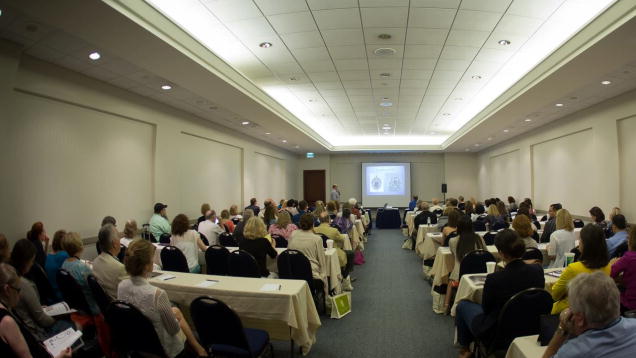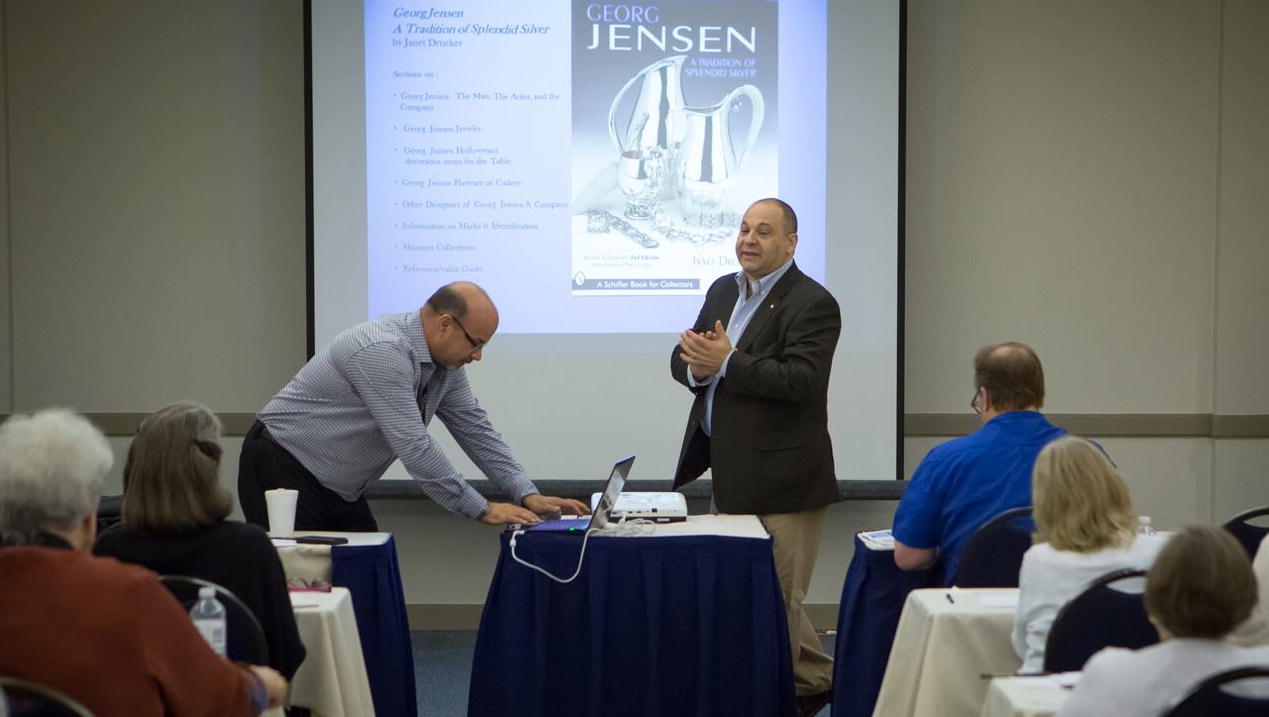Report from Jewelry Camp 2013
September 24, 2013
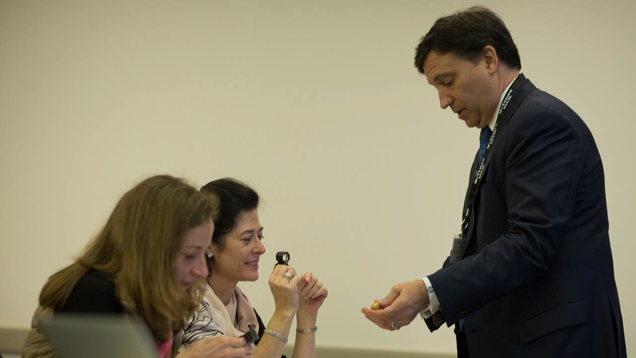

Historians study the styles of the past from portraits like that of Lucina Brembati (left), whose hair, dress, and jewelry indicate a person of upper class. One of her rings bears the coat of arms of the Brembati family, another clue to her noble heritage. Painting by Lorenzo Lotto, circa 1518-1523, from the collection of the Accademia Carrara, Bergamo. The portrait on the right of Bianca Maria Sforza was painted at the request of her husband, Maximilian I, as a condition of marriage, prior to her appointment as Empress of the Holy Roman Empire. Painting by Giovanni Ambrogio de Predis, circa 1493, from the collection of the National Gallery of Art.
Krulick-Belin’s talk was one of many at the 36th annual conference known as “Jewelry Camp.” Held in Atlanta for the first time in 2013, the event was started in Maine by art nouveau jewelry expert Dr. Joseph Sataloff but later moved to New York and changed hands. Joyce Jonas ran the event until 2006, when jewelry appraiser and educator Edward Lewand took over with his wife, Sandy.We had the opportunity to attend this year’s conference, which took place August 1–3 at the Cobb Galleria Centre, in conjunction with the Atlanta Jewelry Show. About 80 jewelry professionals and collectors attended three days of lectures on various aspects of antique jewelry.
Among the experts presenting at this year’s conference were William Drucker of Drucker Antiques, who spoke on the Danish jewelry company Georg Jensen; author and museum consultant Janet Zapata, on Tiffany & Co. jewelry; Ezriel Rapaport of The Rapaport Group, on the secondary diamond market; Joseph DuMouchelle, on selling jewelry at auction; and Tina Joseff, on the costume jewelry designer Joseff of Hollywood. We also attended lectures on identifying Georgian and Victorian jewelry, famous women jewelers, Gothic Revival jewelry in France and England, 150 years of jewelry styles, and internet research for identification and pricing, as well as an accelerated, hands-on assessment of antique jewelry.
George Jensen’s Rare Designs
Over its more than 100-year history, Georg Jensen jewelry has maintained value and is still handmade, said Drucker, a recognized authority on the company’s silver jewelry. Georg Jensen (1866–1935) was trained as a sculptor and began making jewelry in a small workshop in Copenhagen. He worked in art nouveau, a style that still influences the company’s designs. Other Jensen designers brought their own aesthetic and modern influences to their designs. One designer, Arno Malinowski, developed a metalsmithing technique using iron and silver during World War II, when metals were scarce. The product was similar to shakudo, a gold-copper alloy traditionally used in Japan to decorate sword fittings. Malinowski used this technique for only a short time, so these Georg Jensen pieces are rare and highly sought after.Diamond Recycling
Everything old is new again, and diamonds are no exception. Ezriel Rapaport, director of global trading at the Rapaport Group, pointed out that more diamonds are actually coming out of the U.S. than South Africa today, thanks to the secondary market. This is being driven by “diamond recycling” on the part of the baby boomer generation. The generation is either selling off its diamonds or trading up. About $1.5 billion in diamonds are recycled annually, offering jewelers excellent profit margins.
Ezriel Rapaport, director of global trading at the Rapaport Group, talks about the state of the secondary diamond market. Photo courtesy of ASK Media/The Antique Jewelry and Art Conference.
A Jeweler to the Stars
Tina Joseff, president and CEO of Joseff of Hollywood, gave an engrossing account of the company started by her father-in-law in 1928. Eugene Joseff worked in advertising in Chicago before moving to Los Angeles and starting a business designing and manufacturing jewelry for the burgeoning movie industry. He worked with famous costume designers, including Walter Plunkett (“Gone With the Wind” and “An American in Paris”) and Adrian Adolf Greenberg, also known as Adrian Gilbert (“The Wizard of Oz”). Joseff’s jewelry used silver, gold, platinum, plastic, wood and other materials, including natural gemstones. He also developed a secret plating technique so the jewelry wouldn’t reflect the camera lights.Many of the big Hollywood stars were bejeweled in Joseff creations, both on screen and off. Some of the most memorable pieces include Vivien Leigh’s swag necklace in “Gone with the Wind” (1939), Shirley Temple’s crown and scepter in “The Little Princess” (1939), and Judy Garland’s lariat necklace in “Ziegfeld Follies” (1944). When Joseff died in a plane crash in 1948, his wife, Joan Castle Joseff, continued the business and created jewelry for the likes of Marilyn Monroe in “Gentlemen Prefer Blondes” (1953) and “Some Like It Hot” (1959), and Grace Kelly in “High Society” (1956).

This still from the movie "Gone with the Wind," featuring Vivien Leigh and Clark Gable, is composited with the necklace worn by Leigh, which features Austrian amethysts and white sapphires set in sterling silver. Photo courtesy of Joseff-Hollywood.
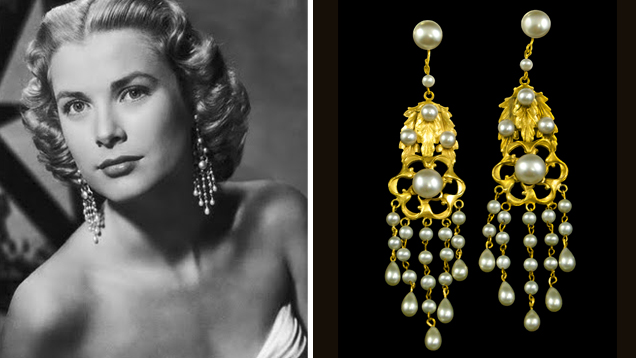 Actress Grace Kelly (left) wore faux pearl earrings (right) for the movie “High Society.” The piece was designed by Joseff of Hollywood, known at one time as the “Jeweler to the Stars.” Photos courtesy of Joseff-Hollywood.
Actress Grace Kelly (left) wore faux pearl earrings (right) for the movie “High Society.” The piece was designed by Joseff of Hollywood, known at one time as the “Jeweler to the Stars.” Photos courtesy of Joseff-Hollywood.Hands-On Purchasing Simulation
Another session was led by Louis Scholz, a gemologist and founder of Fine Jewelry by Louis, a wholesale antique jewelry company, and Brixton & Gill English-made cufflinks. This hands-on session involved the lightning-fast examination of 25 jewelry items. Using only a loupe, with one minute per piece, participants determined each item’s age and gem and metal content and assessed its marks. The experience was humbling but beneficial, as purchasing estate jewelry often requires quick evaluation, along with a keen eye, experience, and good instincts.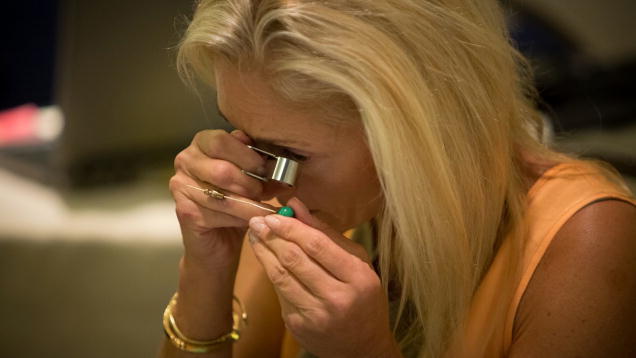
A Jewelry Camp attendee examines a hat pin during the conference’s hands-on purchasing simulation, led by antique jeweler Louis Scholz. Photo courtesy of ASK Media/The Antique Jewelry and Art Conference.
